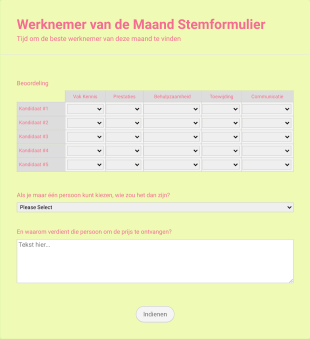Evaluatieformulieren voor werknemers
Over Evaluatieformulieren voor werknemers
Een evaluatieformulier voor werknemers is een tool voor prestatiebeoordelingen die wordt gebruikt om de vooruitgang van werknemers bij te houden door informatie over de vaardigheden, doelen en prestaties van werknemers te verzamelen. Met onze gratis templates voor werknemersevaluatieformulieren kun je online reacties verzamelen om eenvoudig inzicht te krijgen in de sterke punten van werknemers en wat ze kunnen verbeteren. Zodra je de prestatiebeoordeling van werknemers via je computer of mobiele apparaat hebt uitgevoerd, worden de gegevens veilig in je Jotform-account opgeslagen. Vervolgens kun je de evaluaties eenvoudig beheren en in afdrukbare PDF's omzetten!
Om waardevolle werknemersevaluaties voor je bedrijf of HR-afdeling uit te voeren, heb je een krachtige template voor werknemersevaluatieformulieren nodig. Om te beginnen kun je een van onze kant-en-klare templates kiezen en deze volledig aan je wensen aanpassen door de formulierbouwer van Jotform te gebruiken. Op deze manier kun je een krachtig evaluatieformulier maken dat volledig op je behoeften is afgestemd. Je kunt het ontwerp personaliseren, vragen toevoegen en bijwerken, je bedrijfslogo uploaden en meer. Bovendien kun je het formulier visueel aantrekkelijker maken door matrixtabellen en waarderingsschalen toe te voegen! Met onze gratis evaluatieformulieren voor werknemers kun je de vooruitgang van werknemers online bijhouden om papierwerk te verminderen en prestatiebeoordelingen efficiënter uit te voeren.
Veelgestelde vragen
Waarom zijn evaluatieformulieren voor werknemers belangrijk?
Er zijn verschillende redenen waarom evaluatieformulieren voor werknemers een belangrijke tool voor bedrijven zijn. Om te beginnen stimuleren deze formulieren prestatieverbetering door een gestructureerde manier te bieden om de sterke en zwakke punten van een werknemer te beoordelen en te meten. Daarnaast bieden werknemersevaluatieformulieren managers en leidinggevenden de mogelijkheid om gebieden voor prestatieverbetering in kaart te brengen en werknemers constructieve feedback te geven.
Aan de andere kant bieden deze formulieren werknemers de mogelijkheid om haalbare doelen en verwachtingen voor toekomstige prestaties te stellen. Bovendien zorgen evaluatieformulieren voor werknemers ervoor dat de prestaties en verbeteringen van werknemers worden vastgelegd, wat belangrijk kan zijn als werknemers promotie willen maken. Tot slot bieden werknemersevaluatieformulieren juridische bescherming voor zowel het bedrijf als de werknemer omdat de prestaties van werknemers zijn gedocumenteerd.
Wat zijn de belangrijkste elementen van goede evaluatieformulieren voor werknemers?
Goede evaluatieformulieren voor werknemers bevatten meestal identificerende informatie over de werknemer, waaronder naam, functie, afdeling, evaluatieperiode, team, enzovoort. Vervolgens worden de doelen of prestatie-indicatoren van de werknemer vermeld en de methoden om de prestaties op elk gebied te beoordelen.
Over het algemeen bevat het werknemersevaluatieformulier secties voor feedback en tekstuele opmerkingen van zowel de werknemer als de manager om de sterke punten en verbeterpunten van de werknemer toe te lichten. Deze sectie kan worden gevolgd door een plan waarin de stappen voor toekomstige ontwikkeling worden beschreven.
Wat zijn de verschillende soorten evaluatieformulieren voor werknemers?
Evaluatieformulieren voor werknemers kunnen in elke sector en op elk niveau van een organisatie worden gebruikt. Een van de meest bekende soorten werknemersevaluaties is de jaarlijkse prestatiebeoordeling die één keer per jaar wordt uitgevoerd om de algehele prestaties en vooruitgang van werknemers te beoordelen. Deze evaluatie kan 360-gradenfeedback omvatten, waarbij de visie van collega's wordt gebruikt om werknemers een completere beoordeling te geven. De beoordeling kan ook projectgebaseerd zijn, waarbij de prestaties met betrekking tot een specifiek project of een specifieke taak worden geëvalueerd. Er zijn ook specifieke prestatiebeoordelingen voor bijvoorbeeld verkoopmedewerkers om de prestaties van medewerkers van het verkoopteam te meten en te beoordelen.
Een ander soort werknemersevaluatie is een proeftijdbeoordeling, waarbij nieuwe werknemers of werknemers met een proeftijd worden beoordeeld. Tot slot zijn er zelfevaluaties, waarbij werknemers hun eigen prestaties kunnen beoordelen voordat ze deze met hun managers bespreken.
Wat zijn de best practices voor het gebruik van evaluatieformulieren voor werknemers?
Houd rekening met de volgende punten om het maximale uit je evaluatieformulier voor werknemers te halen:
- Voer evaluaties regelmatig uit: Bepaal vooraf welke periode er tussen het uitvoeren van evaluaties zit. Dit biedt werknemers de mogelijkheid om zich voor te bereiden en zorgt voor consistentie.
- Leg de nadruk op open communicatie: Zorg tijdens evaluatiegesprekken voor een open dialoog om vertrouwen tussen managers en werknemers te creëren.
- Geef managers trainingen: Leer managers hoe ze werknemers op de juiste manier kunnen evalueren door constructieve feedback te geven en werknemers te helpen om haalbare doelen te stellen.
- Documenteer het evaluatieproces: Leg evaluaties en gesprekken nauwkeurig vast voor toekomstig gebruik.
- Gebruik consistente evaluatiecriteria: Zorg voor een consistent evaluatieproces dat voor elke werknemer hetzelfde is om eerlijke beoordelingen te geven.
Wat zijn de voordelen van evaluatieformulieren voor werknemers?
Evaluatieformulieren voor werknemers bieden veel voordelen die vooral op prestatieverbeteringen van werknemers zijn gericht. Deze formulieren kunnen managers helpen om verbeterpunten voor werknemers in kaart te brengen en een plan te maken om werknemers te helpen doelen te bereiken. Deze informatie kan de professionele ontwikkeling ondersteunen en zorgt ervoor dat de prestaties van werknemers worden erkend. Bovendien bevorderen regelmatige werknemersevaluaties constructieve gesprekken tussen werknemers en managers die de werkrelaties kunnen verbeteren.
Evaluatieformulieren voor werknemers kunnen ook belangrijke gegevens opleveren die HR-afdelingen kunnen gebruiken om beslissingen over promoties, loonsverhogingen of ontslag te nemen. Daarnaast bieden deze formulieren bescherming tegen ongegronde juridische claims over de behandeling van werknemers.

